Authentic Bibimbap Under 1 Hour
Learn to make authentic Korean bibimbap easily at home with this detailed guide. This Korean rice bowl recipe features rice, sautéed veggies, ground beef bulgogi, a fried egg, and a homemade red bibimbap sauce. Get tips, tool recommendations, and recipe variations to make this dish in under an hour.
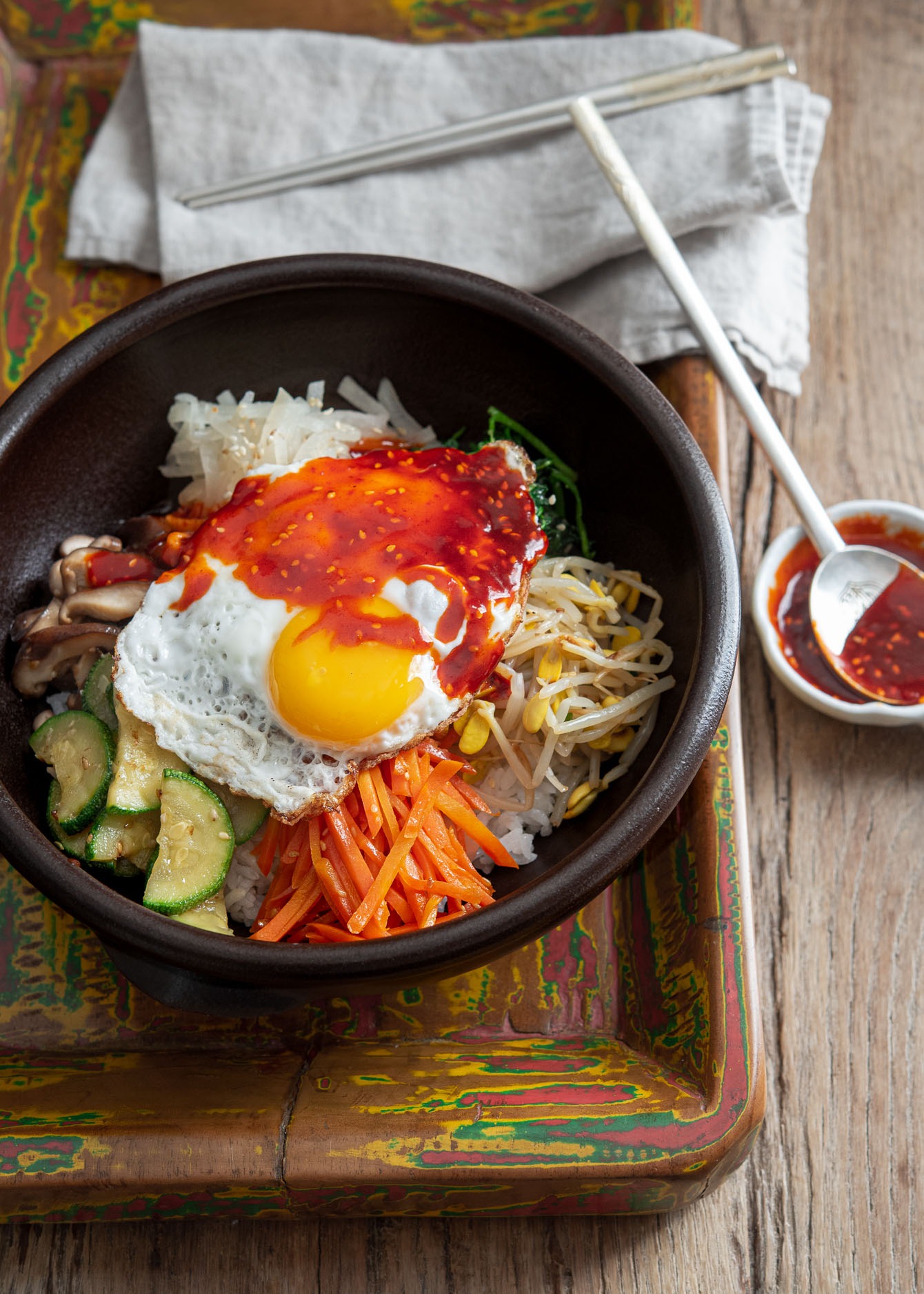
Bibimbap is a unique Korean rice bowl dish that has gained popularity in many households, even if you’ve never been to Korea. Similar to bulgogi, japchae, and Korean fried chicken, you can easily find this traditional meal on the menu of local Korean restaurants in your neighborhood.
Once you try bibimbap, you’ll be hooked! Fortunately, you can make this wholesome and healthy dish at home with a simple and easy recipe that takes less than an hour to prepare. You can even increase the amounts of each ingredient to feed a larger group of people.
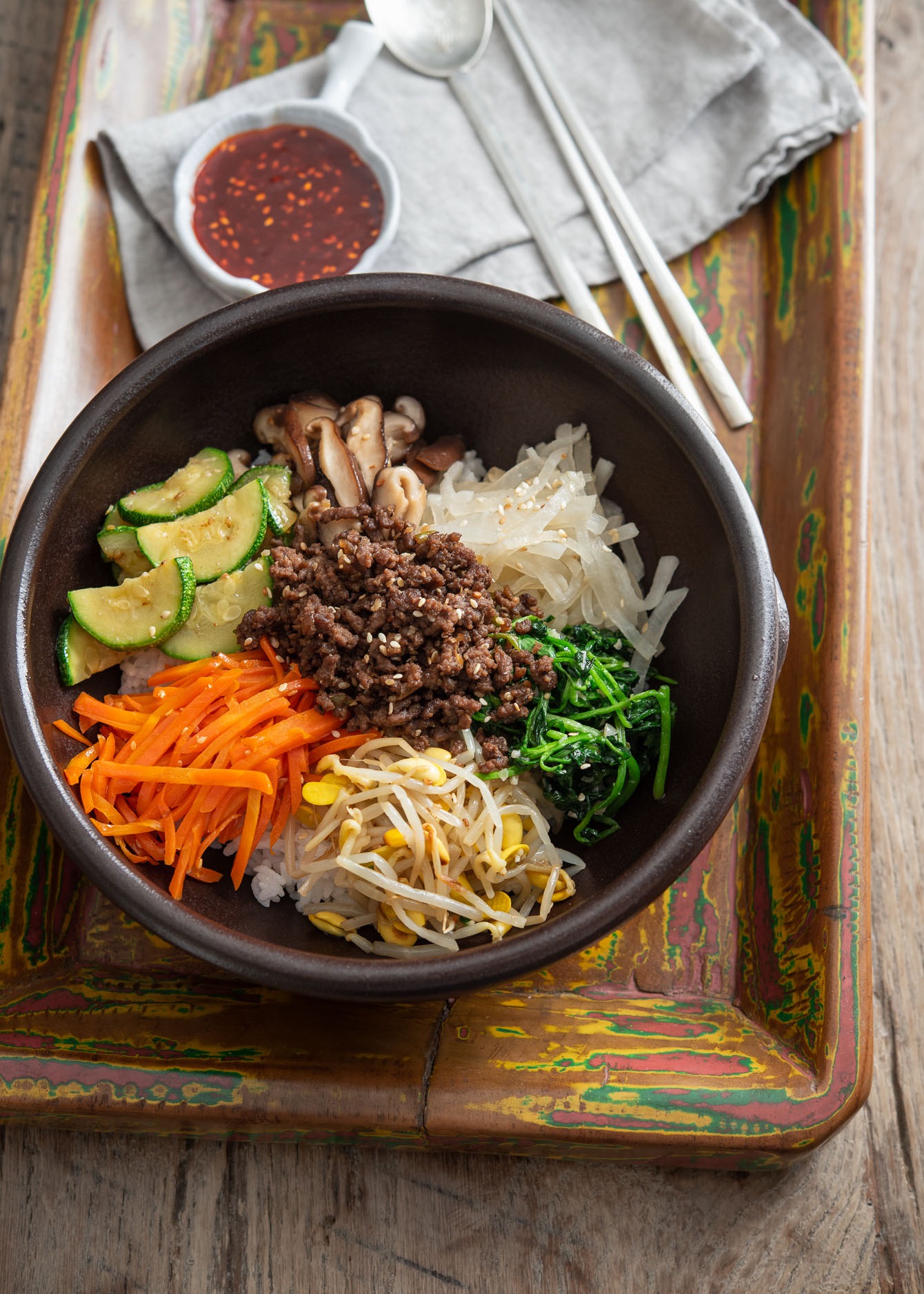
What is bibimbap?
The literal translation means mixed rice–“bibim” means to mix, and “bap” means cooked rice. You can pronounce as it says; Bi-Bim-Bap.
It is, perhaps, the most well known dish among Korean rice dishes. A bowl of rice is arranged with all sorts of seasoned vegetables and meat (typically beef), and topped with a sunny side up fried egg.
You can enjoy the rich flavor and the crisp texture of each ingredient in every bite. This Korean rice bowl is served with a sweet and spicy bibimbap sauce made with gochujang–Korean chili paste.
The homemade gochujang sauce has become super popular in recent years. It is used to dress up many dishes in Korean and other cuisines. My cookbook, Korean cooking favorites, also shares another delicious recipe.
Dolsot Bibimbap
Bibimbap comes in two variations: regular and dolsot.
The regular version is typically served at room temperature in a large bowl made of stainless steel or porcelain. In contrast, dolsot bibimbap should be served hot in a heated stone pot.
For that reason, the dolsot bibimbap variation is often preferred during colder weather, as it retains its heat and warmth for longer.
To serve it, the stone pot can be placed directly on a heat source, ensuring that the rice and toppings stay piping hot until the very last bite.
How to make dolsot bibimbap in a skillet:
Instead of using a stone pot, a heavy-duty cast iron or carbon steel skillet is heated on the stovetop to create the signature crispy rice crust at the bottom of the bowl.
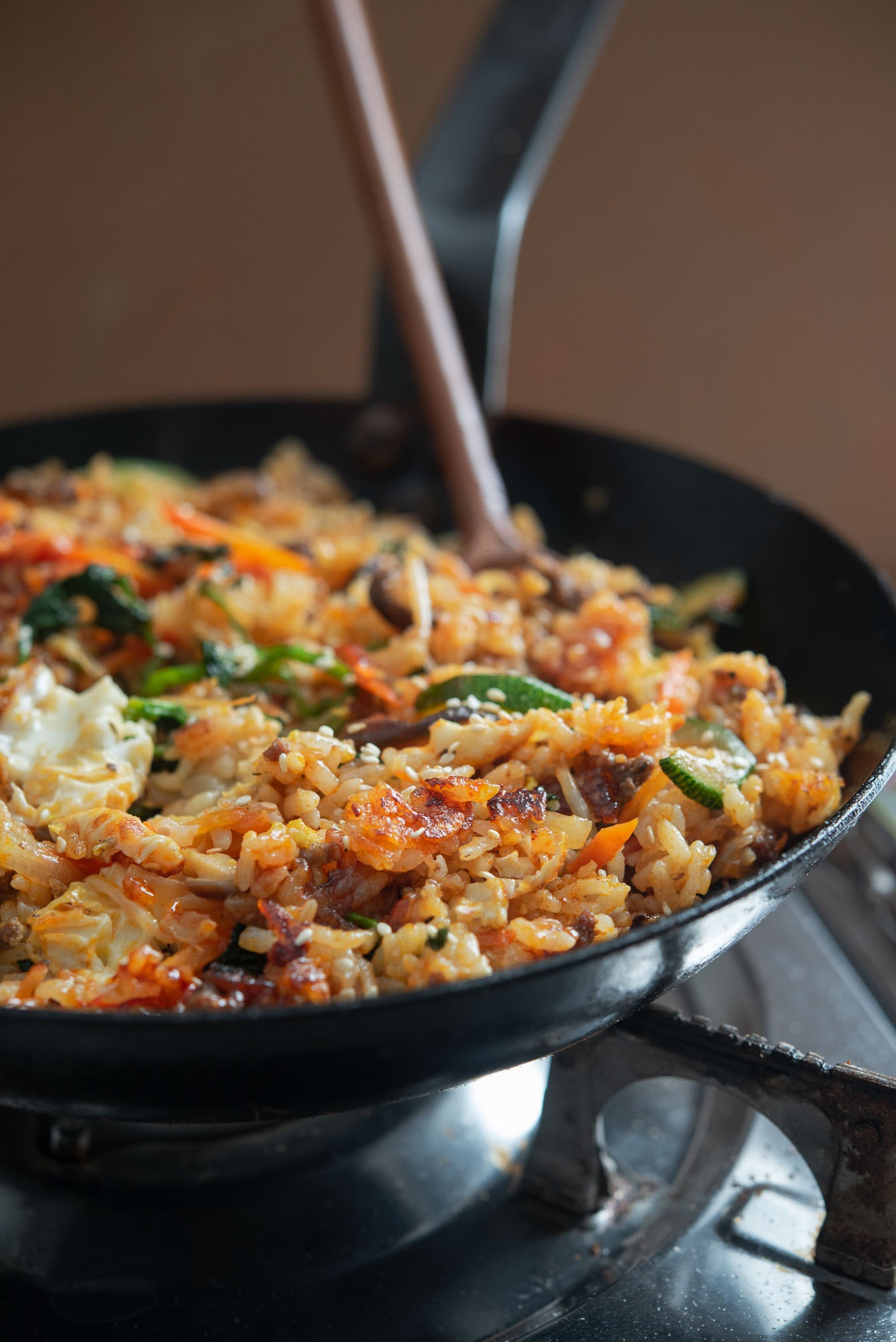
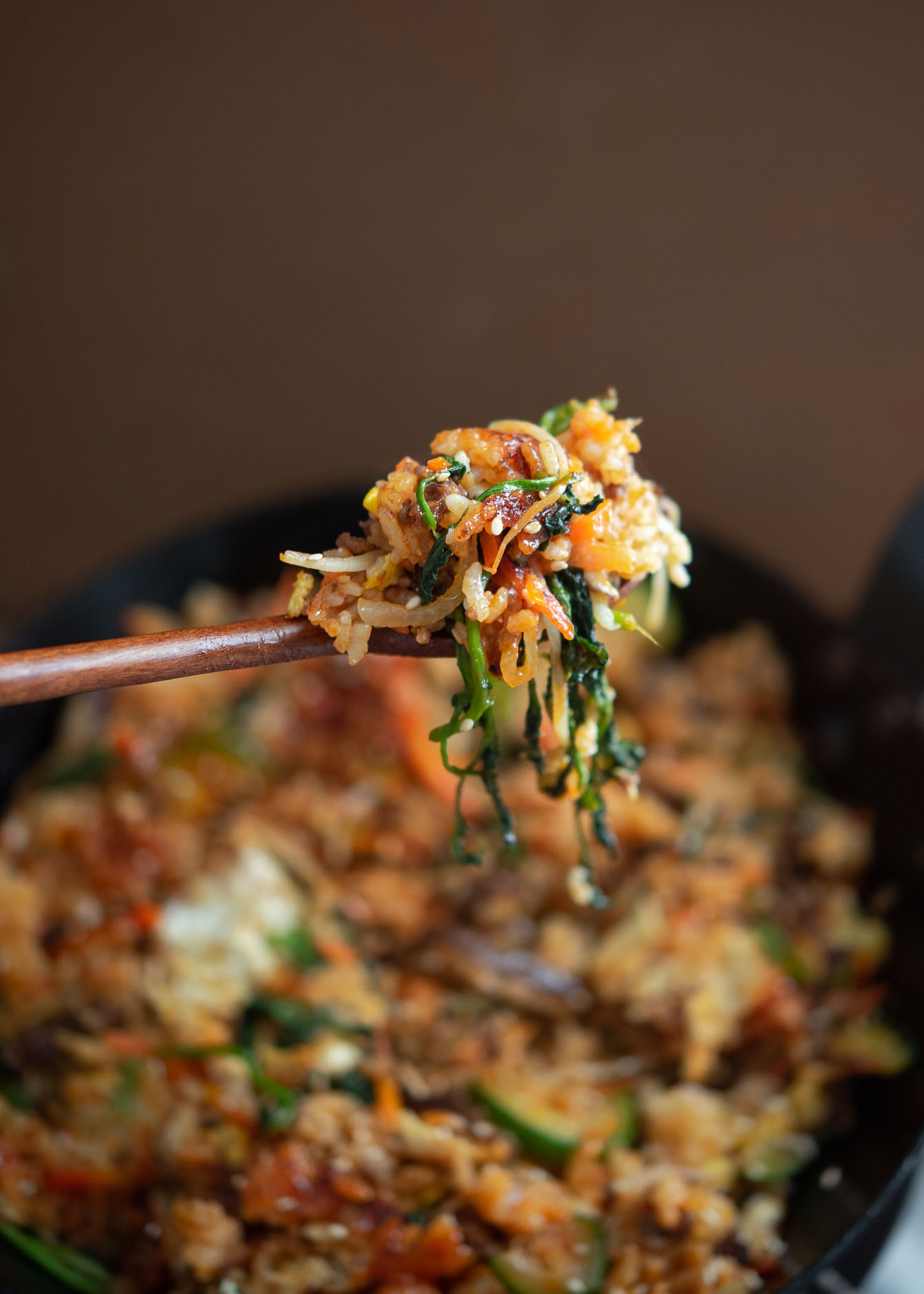
The skillet method also allows for greater control over the cooking process and makes it easy to customize the ingredients to your liking. This tasty and satisfying meal can be enjoyed any time of year and is sure to become a new favorite!
Check my recipe video below to see how dolsot bibimbap is made in a skillet (at 4:09).
Watch bibimbap recipe video
Bibimbap Vegetables
While the options for the vegetables are endless and you can use any number of them. The vegetables used in bibimbap recipe are collectively called namul (나물).
On their own, they are Korean vegetable side dishes. When you consider what vegetables to use, always strive for a color contrast to make it look more appetizing.
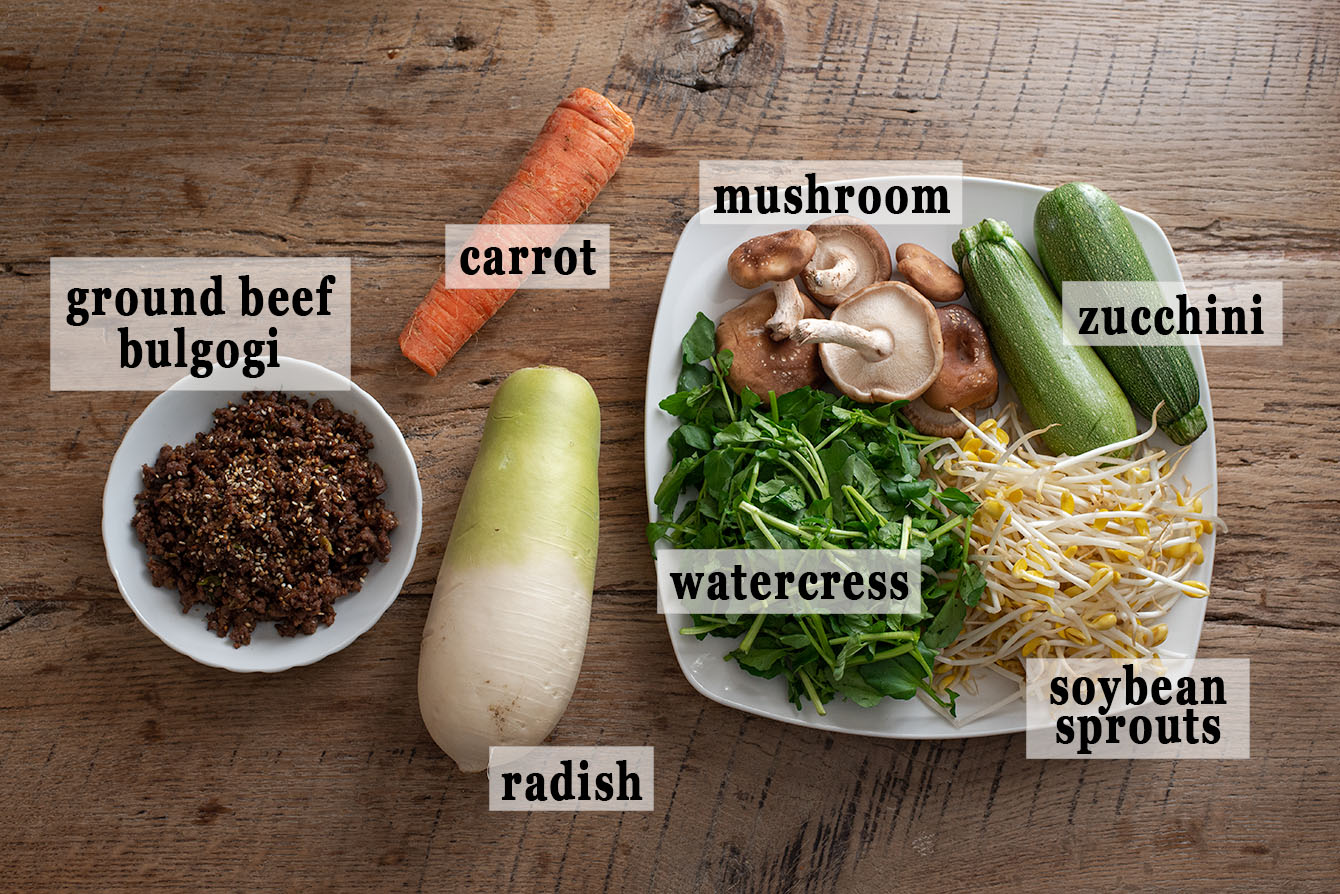
Most commonly used vegetables are:
- Soybean sprouts or mung bean sprouts – These add a crunchy texture to the dish. For detailed instructions on how to prepare them, check out my bean sprout side dish recipe.
- Spinach – This leafy green vegetable is a classic ingredient. Try my Korean spinach side dish to prepare it.
- Watercress – If you prefer a milder flavor than spinach, watercress is a great alternative. The best part is you can skip the blanching process.
- Carrot – adds a nice crunch texture and color contrast.
- Zucchini (fresh or dried) – A common ingredient in bibimbap. You can use fresh or dried zucchini.
- Swiss chard – A nutritious addition to the dish.
- Radish – The mellow taste of Koran radish balances out the other flavors. I love the addition of white color it adds.
- Eggplant – This soft and tender vegetable adds a great texture to the dish.
- Bracken (gosari) – Needs some work to prep beforehand (see my Yukgaejang recipe for the idea)
- Mushroom – Although not one of the traditional “namul” vegetables, but mushrooms are always included in bibimbap. Shiitake mushrooms are the most common, but other types are fine as well.
Cooking Tip: To ensure that each vegetable retains its natural color, it’s best to start by cooking the lightest-colored vegetable (such as radish) first and then progress to the darker-colored vegetables. This method also allows you to use just one skillet, making cleanup easier.
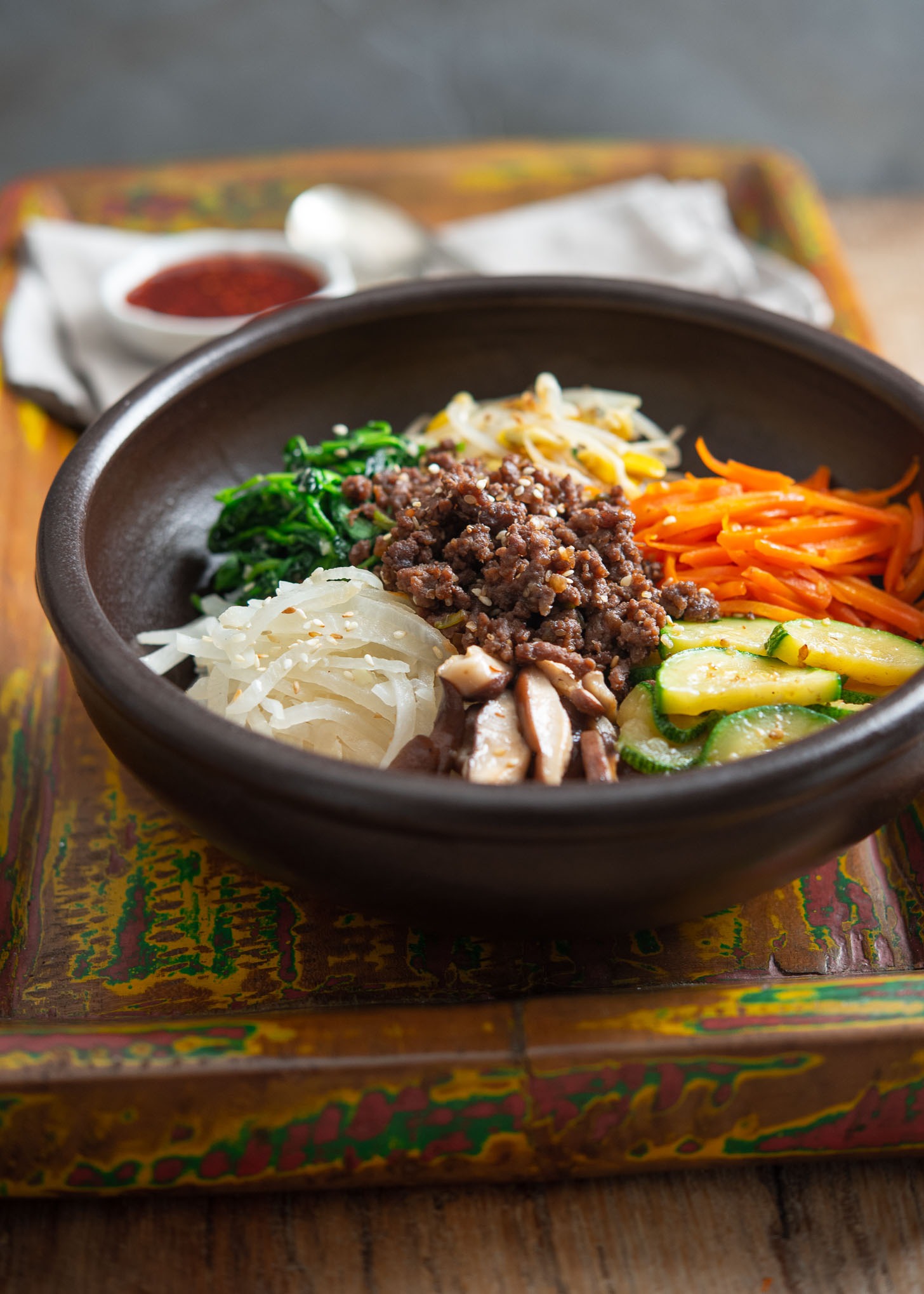
Meat
Beef is a common protein addition, but it’s entirely optional. If you prefer a vegetarian or vegan version of the dish, you can omit the beef altogether or replace it with another plant-based protein of your choice.
Many recipes use traditional marinated beef bulgogi, which requires several hours or even a day of preparation in advance.
An easy alternative is to use ground beef (see my Korean ground beef recipe) instead. It takes less than 15 minutes to prepare and is just as tasty as the marinated beef version. Plus, ground beef is easier to mix with the rice and vegetables than larger chunks of beef.
For a variety of flavors, other meat toppings can be used, such as chicken bulgogi, pork bulgogi or spicy squid stir-fry. These options make it easy to customize your bibimbap to your liking.
Bibimbap Sauce
While vegetables and meat are important component, the red bibimbap sauce is essential for creating the dish’s signature flavor. Here’s an easy recipe to make your own sauce:
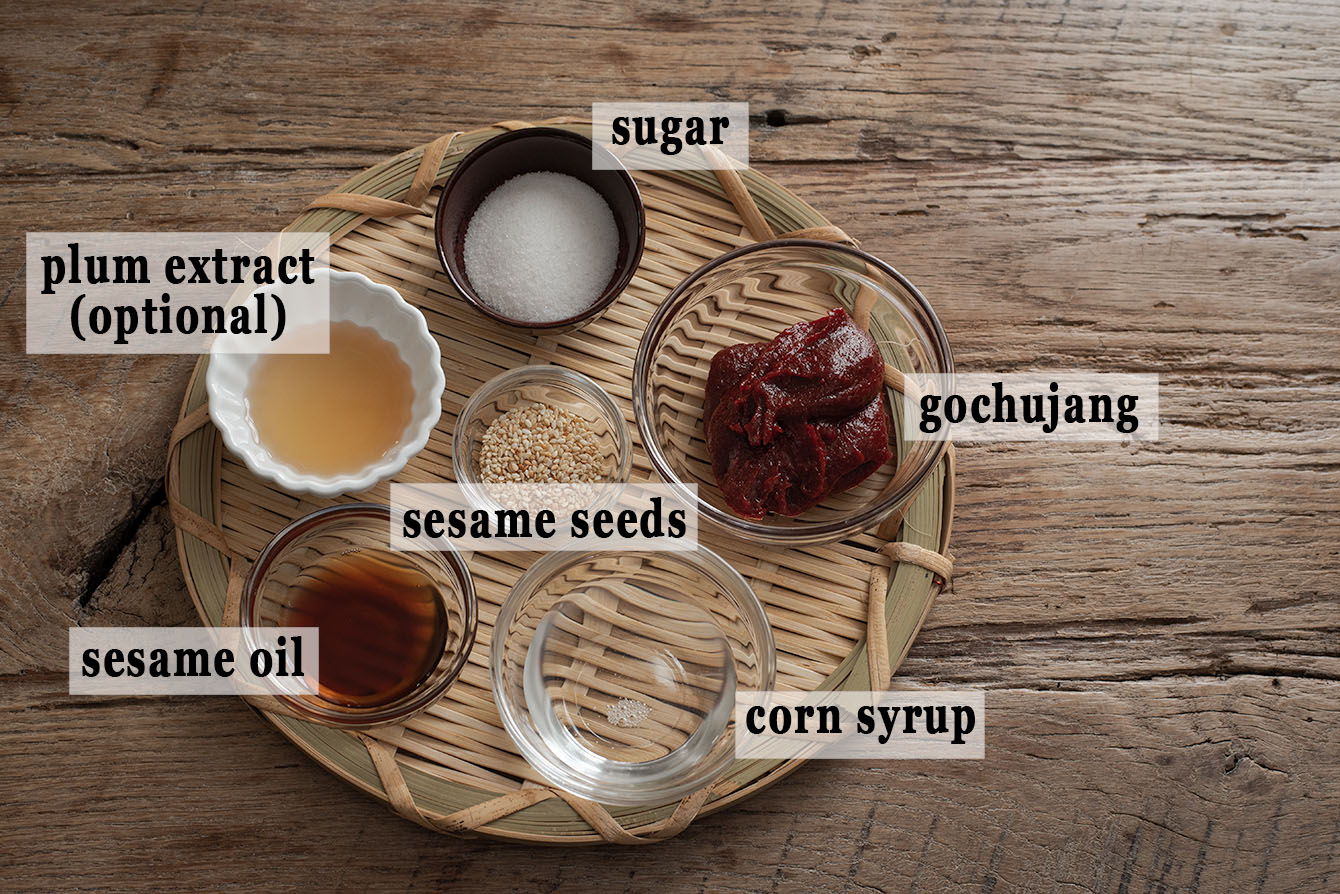
- Gochujang (Korean chili paste): This spicy, savory paste is a staple in Korean cuisine and adds heat and depth of flavor to the sauce.
- Korean plum extract (optional, but recommended): This sweet and tangy extract adds a unique twist to the sauce and complements the spicy gochujang.
- Corn syrup or sugar: These sweeteners balance out the spiciness of the gochujang and add a touch of sweetness to the sauce.
- Sesame oil: Aromatic oil adds a nutty flavor to the sauce and helps to bring all the ingredients together.
- Toasted sesame seeds: Add texture and flavor to the sauce.
If you want to take your bibimbap sauce to the next level, try my ultimate homemade gochujang sauce recipe.
How to make bibimbap
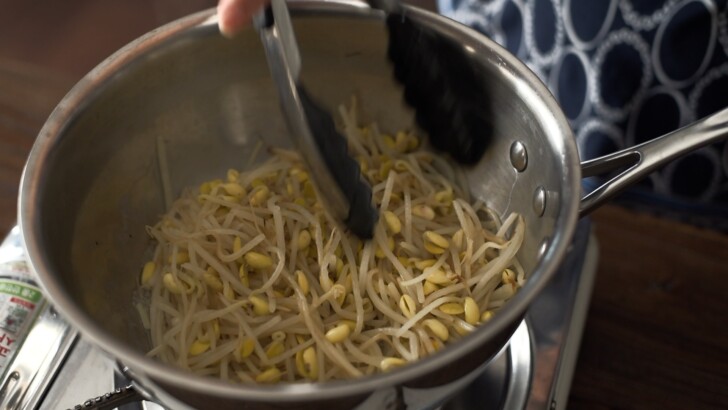
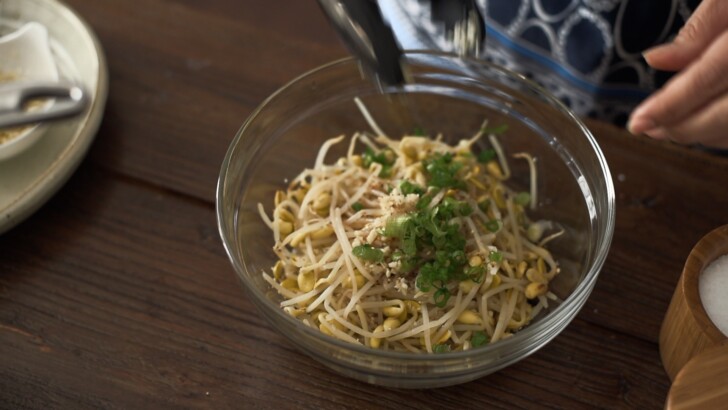
Step 1. Soy bean sprouts
- Blanch sprouts in boiling water for 5 minutes and drain.
- Season with a a mixture of minced garlic, Korean soup soy sauce, salt, sesame oil, sesame seeds, and finely chopped green onions. Toss well.
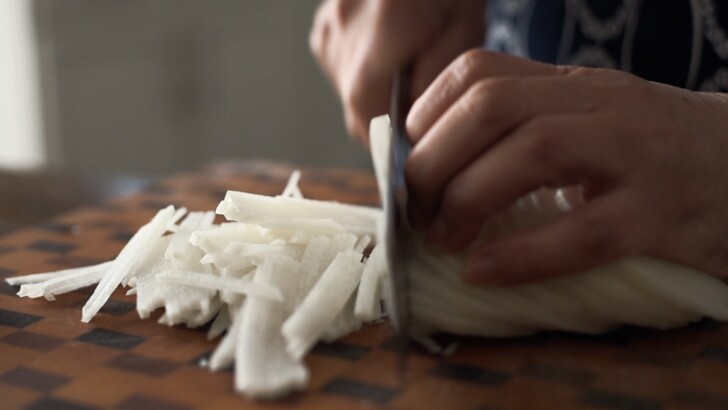
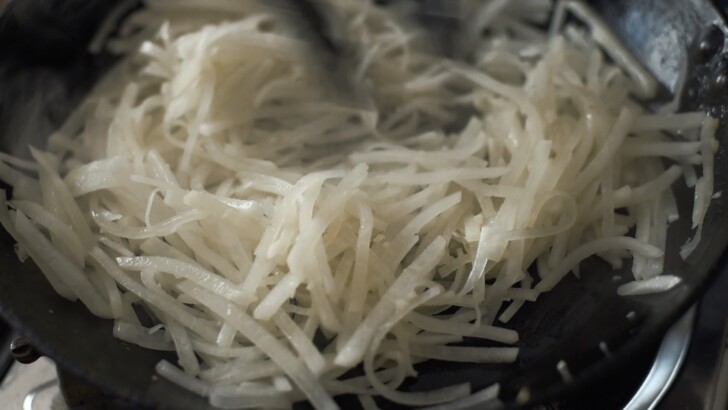
Step 2. Radish
- Slice radish into thin matchsticks. Heat oil in a skillet over medium heat. Add minced garlic and cook for 30 seconds.
- Add radish slices and a couple pinches of salt, and toss well. Cover with a lid and cook until soft, about 2 minutes.
- Drizzle a little sesame oil. Taste and add more salt if needed.
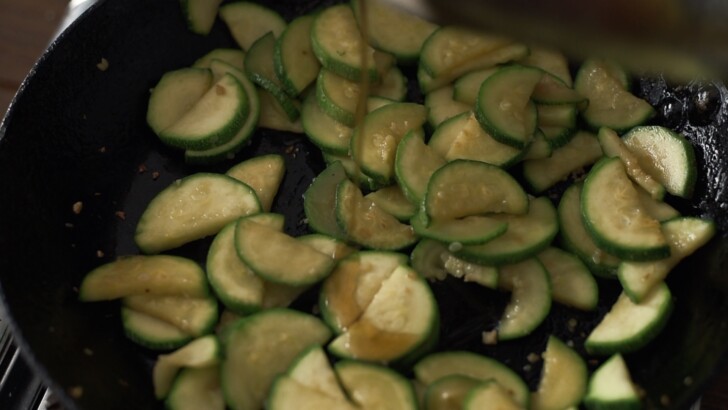
Step 3. Zucchini
- Heat 1 tablespoon oil in a skillet over medium heat. Add garlic, zucchini slices, and salt. Stir fry until soft, about 1-2 minutes.
- Add sesame oil and sesame seeds. Toss well
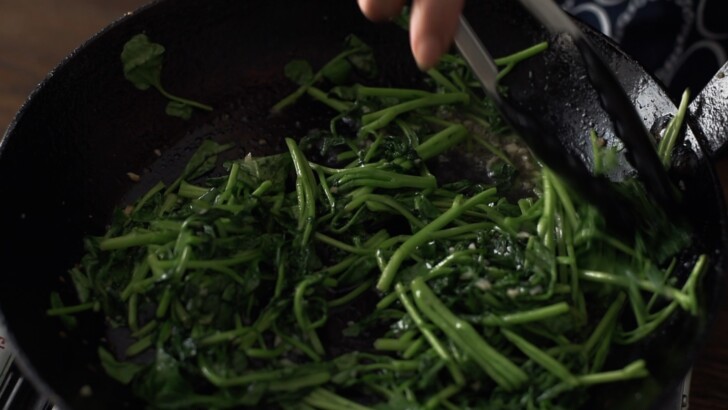
Step 4. Watercress
- Stir-fry watercress in hot oil with minced garlic; cook for 1 minute.
- Drizzle Korean soup soy sauce and cook until wilted.
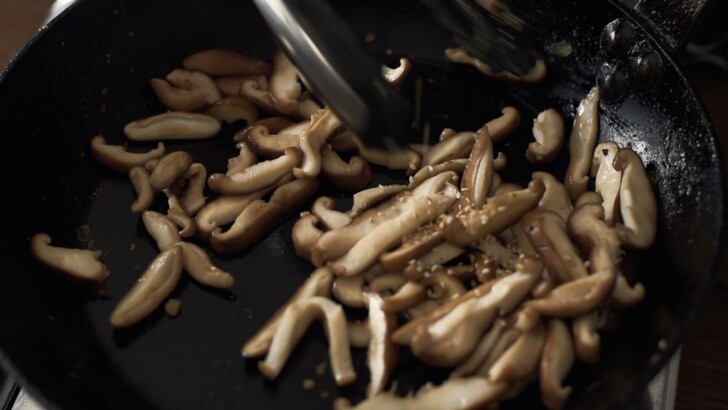
Step 5. Mushrooms
- Add 1 tablespoon oil in a skillet, add the minced garlic and the mushrooms; stir fry for 1 minute. Drizzle Korean soup soy sauce and cook until soft.
- Sprinkle in toasted sesame seeds at the end and toss.
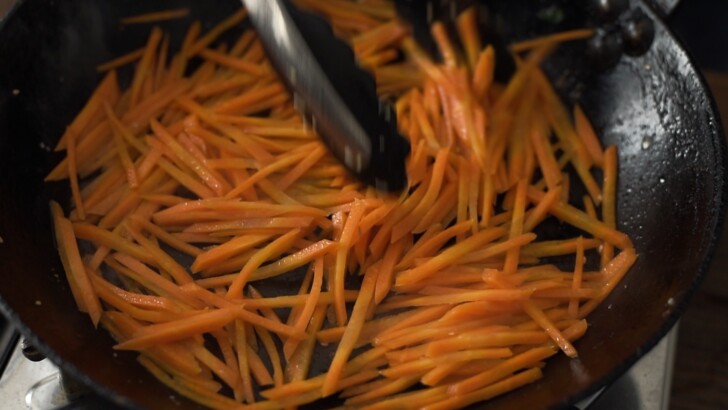
Step 6. Carrots
- Stir-fry carrot in hot oil with salt and cook together for 30 seconds. Pour in 2 tablespoons water to create steam and cover with a lid immediately. Cook for 1-2 minutes until soft.
- Sprinkle toasted sesame seeds at the end and toss.
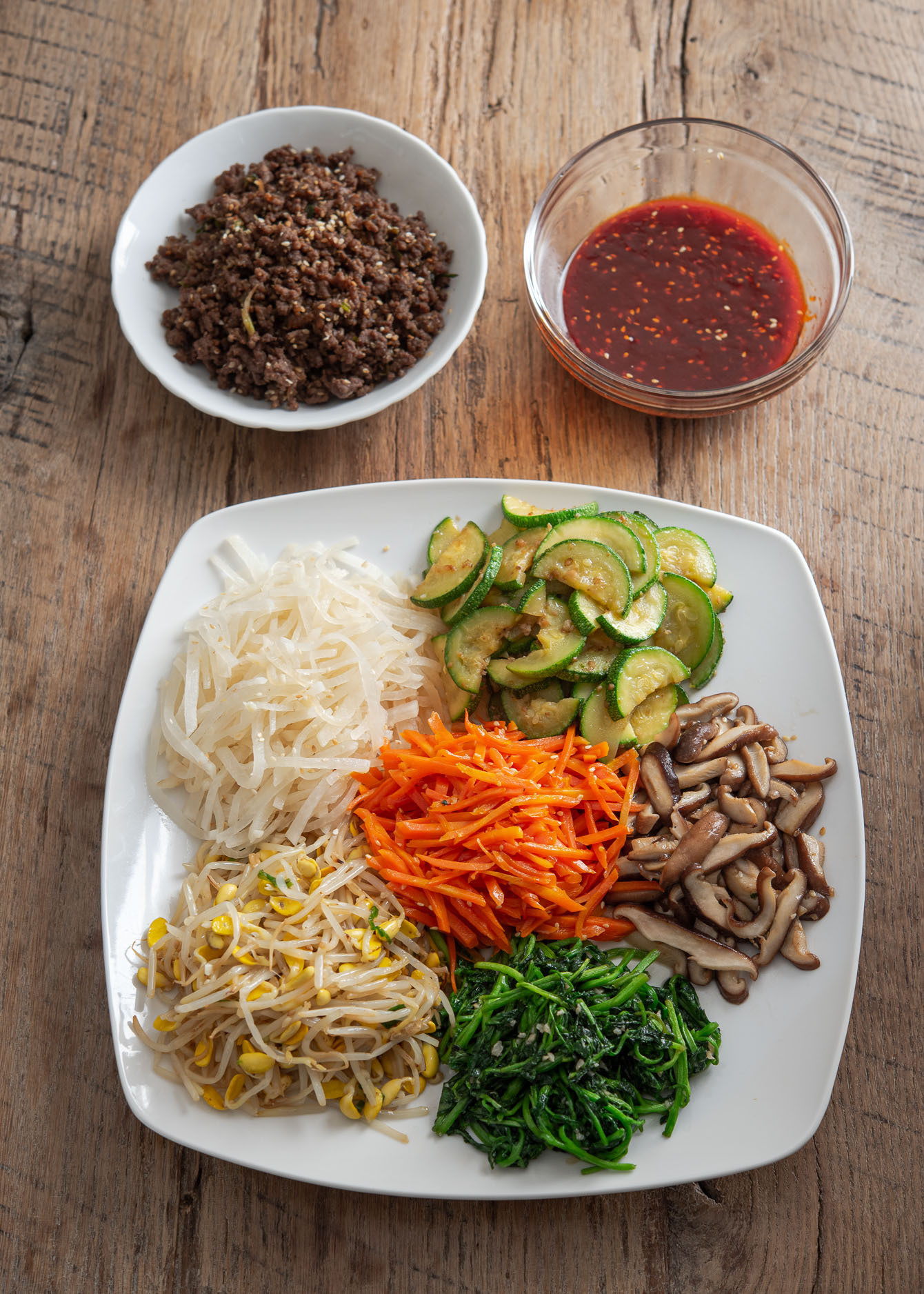
Assembling vegetables
- Put a desired amount of rice on the bottom of a large individual serving bowl.
- Arrange the vegetables on top of the rice in alternating colors for a good visual presentation. Put bulgogi meat (bulgogi ground beef) in the center.
- Place a fried sunny side-up egg on top.
- You can either drizzle the bibimbap sauce (about 2 tablespoon) directly over the rice bowl, or you can put the sauce in a small sauce bowl on the side next to the bibimbap so that your guest can add the sauce directly to the bowl in their desired amount.
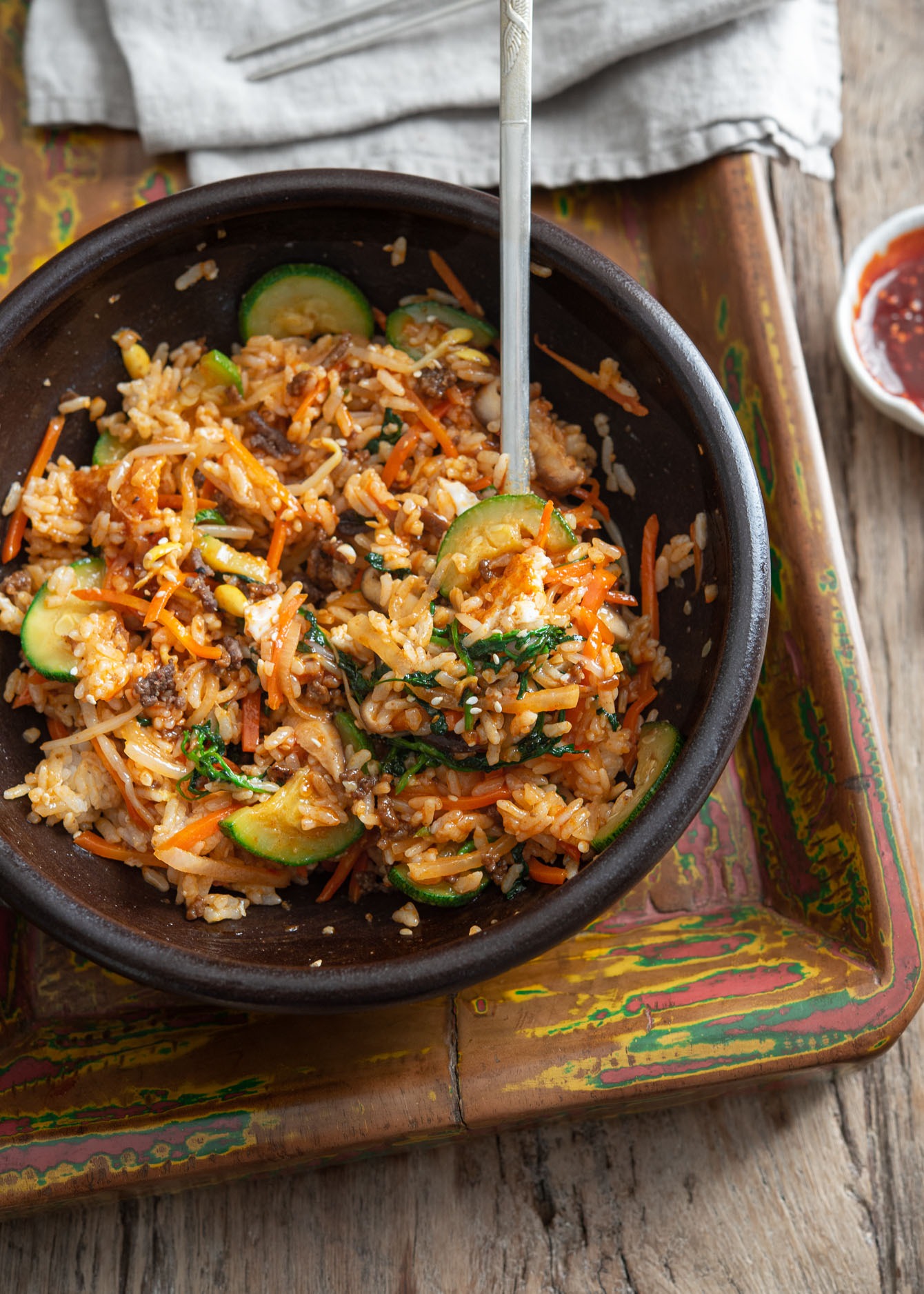
Serving Tips
It’s common to top this traditional Korean mixed rice bowl with a fried egg. You can choose to make a sunny-side-up (see my gyeran bap recipe) or over-easy egg, which allows the runny yolk to mix with the rice and create a delicious flavor combination.
Eating bibimbap is a fun and interactive experience. Here’s how to enjoy it:
Mixing:
Your bibimbap may look almost too beautiful to eat, but mixing everything together is essential for maximum flavor. While you can use a spoon to mix it, the easiest and most common method is to use chopsticks.
- First, use the chopsticks to break up the egg yolk and white in a cross pattern.
- Then, hold both chopsticks in one hand and toss the rice and vegetables together to mix in the sauce.
- Finally, use a spoon to coat everything evenly. Check out my tutorial video for a visual guide.
Serving:
Once you mix everything together, take a big spoonful and savor the combination of rice, meat, and vegetables coated in a savory gochujang sauce.
- Since bibimbap already has a variety of vegetables mixed in, you don’t need any additional side dishes besides kimchi. To round out the meal, you can serve a light soup made with soybean paste or kimchi soup.
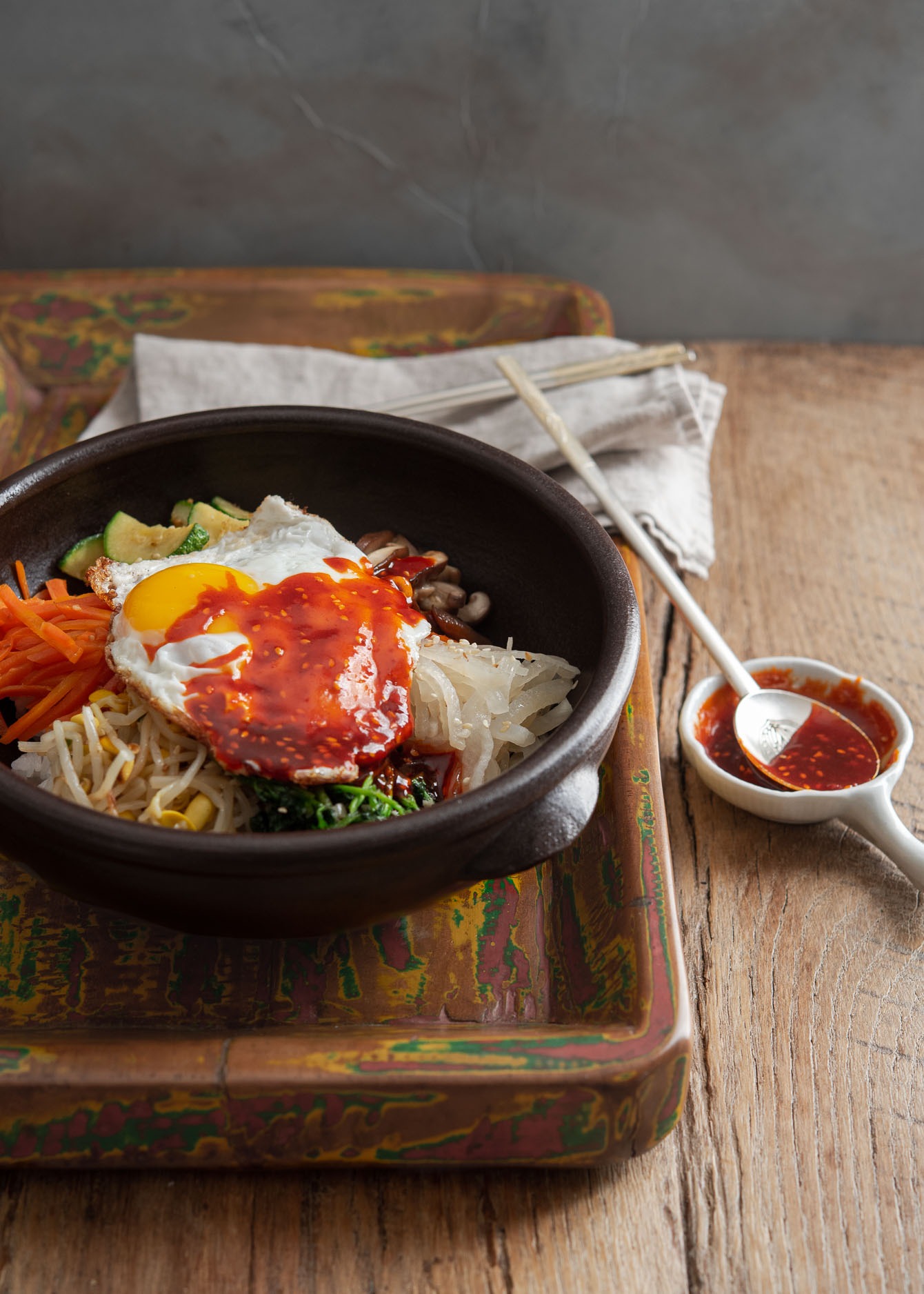
More rice dishes
If you are looking for other Korean rice dishes, you will love these simple rice bowl recipes:
- Bacon Kimchi Fried Rice (Kimchi Bokkeumbap)
- Egg Fried Rice
- Kimbap (Gimbap)
- Korean Egg Rice
- Rice Balls
- Spam Fried Rice
Tried this recipe? Please take a moment to leave a star rating & comment below. I love hearing from you and it helps other readers, too.
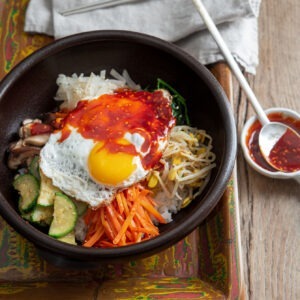
Authentic Bibimbap Under 1 Hour
Recipe Video
Ingredients
Bibimbap sauce
- 4 tbsp Korean chili paste (gochujang)
- 1 tbsp Korean plum extract (maeshil cheong), optional
- 2 tbsp corn syrup, or 1 tbsp sugar
- 1 tbsp sesame oil
- 1 tbsp toasted sesame seeds
For bibimbap
- 6 cup freshly cooked white rice
- 6 egg
- 1 lb ground beef bulgogi, see not below for vegetarian or vegan option
Bibimbap vegetables
- 1 lb soybean sprouts
- 1 lb Korean radish, sliced into very thin matchsticks
- 2 small zucchini, sliced
- 1 bunch watercress, sliced
- 6 oz shiitake mushroom, thinly sliced
- 2 carrots, sliced into thin matchsticks (see note)
Vegetable seasonings
- 3 tbsp minced garlic, divided
- 2 tbsp Korean soup soy sauce (gukganjang), divided
- 2-3 tsp salt, to season, divided
- 2 tbsp sesame oil, divided
- 2 tbsp toasted sesame seeds, divided
- 1 green onion, finely chopped
Instructions
To make bibimbap sauce
- Combine all the ingredients in a bowl and mix well; set aside.
To make bibimbap vegetables
- For the soybean sprouts, blanch them in boiling water for 5 minutes and drain. Season with a a mixture of 1 teaspoon minced garlic, 2 teaspoons Korean soup soy sauce, pinch salt, 1 teaspoon sesame oil, 2 teaspoons sesame seeds, and 2 tablespoons finely chopped green onions. Toss well.
- For the radish, heat 1 tablespoon oil in a skillet over medium heat. Add the 2 teaspoons of minced garlic and cook for 30 seconds. Add radish slices and a couple pinches of salt, and toss well. Cover with a lid and cook until soft, about 2 minutes. Drizzle 2 teaspoon of sesame oil. Taste and add more salt if needed.
- For zucchini, heat 1 tablespoon oil in a skillet over medium heat. Add 2 teaspoons garlic, zucchini slices, and salt. Stir fry until soft, about 1-2 minutes. Add 2 teaspoon sesame oil and 1 teaspoon sesame seeds. Toss well.
- For watercress, heat 1 tablespoon oil in a skillet over medium heat, add the 2 teaspoons of minced garlic and watercress; stir fry for 1 minute. Drizzle 2 teaspoon Korean soup soy sauce and cook until wilted.
- For mushrooms, heat 1 tablespoon oil in a skillet over medium heat, add the 2 teaspoons minced garlic and the mushrooms; stir fry for 1 minute. Drizzle 2 teaspoon Korean soup soy sauce and cook until soft. Sprinkle in 1 teaspoon toasted sesame seeds at the end and toss.
- For carrots, heat 1 tablespoon oil in a skillet over medium heat. Add carrot and salt and toss together for 30 seconds. Pour in 2 tablespoons water to create steam and cover with a lid immediately. Cook for 1-2 minutes until soft. Sprinkle 1 teaspoon toasted sesame seeds at the end and toss.
For ground beef and egg
- Cook ground beef bulgogi according to the recipe direction.
- For eggs, fry eggs to sunny-side up or over easy in hot oil.
Assembling Bibimbap
- Put a desired amount of rice on the bottom of a large serving bowl. Arrange the vegetables on top of the rice in alternating colors for a good visual presentation. Put bulgogi meat in the center. Place an sunny-side up egg on top.
- You can either drizzle the bibimbap sauce (about 2 tablespoon) directly over the rice bowl, or you can put the sauce in a small sauce bowl on the side next to the bibimbap so that your guest can add the sauce directly to the bowl in their desired amount.

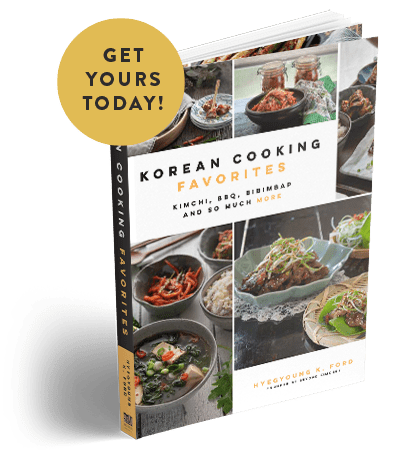
Thank you for your easy video presentation, so simple and quick. I will try to make this recipe for my family tonight.
Fantastic! The chili paste sauce was excellent. Simply delicious.
can you make bibimbap without onions or garlic? substitutes are okay, just not sure what if you can still make it.
Hi Melody, you can omit the onion and garlic in the recipe. It will make the dish milder in overall flavor.
Am eating this now. Thanks! You solved the long-mysterious cucumber riddle for me: restaurant bibimbap (first tried whilst living in Seoul–love!) tasted like cucumber, but was it really cooked first or did it heat up in the dol sot? Mmmm–this tastes like heaven! Haven’t had this taste of cucumber since late nights doing the obligatory student outings in Shinchon and Itaewon with Gangnam thrown in every once and a while. Thanks…
This was a great dish. One question though, I live in Belgium and it s difficult to buy Korean soy sauce, I used Kikkoman instead or is it better to use the Chinese soy sauce version?
Thanks for sharing all those delicious recipes
Sylvia
Hi Sylvia
I prefer Kikoman soy sauce over Chinese version. I am glad to hear that you liked the Bibimbap. Yum!
Thank you! Love it!
My absolute favorite Korean dish! In Hawaii, we can get the fern ( we call warabi) quite easily ( the dried as well, but i like the fresh better) fresh, it has a nice crunchy texture. Love all Korean food – had the unusual experience of being he only Portugese boy working in a Korean restaurant for almost 26 years lol. The menu was a Hawaiian style localized Korean foods, but the food in the back f restaurant that the Korean owners cooked …O MY!!! The Owners Mom cooked made every kinda of kim chee you can imagine , home made Korean miso paste, korean pickles … everything. She is now 85 years old, and can still outwork ANYONE in that kitchen – amazing woman that cant speak a lick of English, but the sweetest, kindest woman I know. And man can she COOK!!. The owners husband would come out everyday, and make all kinds of banchan for everyone’s lunch, and got me hooked on things like black spaghetti, ginseng chicken and spicy pork belly cooked with kochujang, a little dashi, bell peppers and onions and served over rice. Family would always come visit and bring persimmons, Korean mochi, and all the marvelous foods linked to the Korean holidays. I found my self hugely complimented when I was continually asked to make tofu and kimchee chigae, yook gae jung, seaweed and beef soups and other Korean specialties for the owners and family, and pregnant and/or sick women over the Korean workers !!!
haha..was a very nice experience, becoming “adopted” to another culture – in Hawaii, ive experienced that with Japanese, Hawaiian, Filipino, Samoan and many other cultures – but Korean people had the BEST and most intriguing foods… except for the bottle of prepared fish guts my boss always brought to the table for her rice !! 😀
But my first love was always bibimbap. Great site, love all your recipes – thanks for sharing!!
Wow, thanks Robert. I think you truly are a Korean food lover. I think Hawaii must have very good Korean restaurants. Lucky you that you get to try so many variety of Korean food. Thanks for you wonderful comments.
Hi. Bibimbap has been an instant favorite eversince I was introduced to Korean food. I was wondering, is there a way to have a simplified bibimbap? What about seafood bibimbap? Thanks.
A simple, yet tasty Bibimbap we make is just rice in the bowl (sticky, short grain rice of course!), a little high quality sesame oil dribbled over the rice, julienne japan cucumbers, Korean daikon, some blanched mung bean sprouts, watercress and choi sum – each seasoned with a little salt , sesame oil, garlic and pepper – topped with kochujang , some fine-chopped teriyaki rib eye ( just fry it up in a pan or grill),and a fried egg. you can realty go as simple as you want with the veggies, or leave out anything you dont like, To me, the real flavor i cant do without is the teri beef, fried egg ( not hard, over easy so some yolk runs out..yum!) . sesame and kochujang – it makes th3 dish in my opinion.
hi…i made this food for my little family…and my hubby love it…and so do i…cant imagine the taste is great like that…i made with doraji , carrot, and bulgogi…really great…thx for your recipe..^_^
Thank you for such a fast response!
“Namools can be stored in the fridge over a week.” *cheers!*
I went to my H-Mart in New Jersey (I love them so much) and have everything to make this tonight! Brackens have been soaking overnight. My question: will namool keep in the fridge overnight?
Namools can be stored in the fridge over a week. For the Brackerns, after the overnight soaking, cook in the water for 45-60 minutes until tender. Add a little bit of baking powder or sugar might help to tenderize them. Good luck and enjoy your hard work!
i am so thankful for this site! I really need to make a trip to the Korean store. I love hearing the Korean language it is so awesome!
Hi Kay
Thank you for visiting my site. I hope you make a trip to Korean store and buy lots of god Korean stuff, and explore on Korean cooking. Do you speak Korean?
I just found you site. This is awesome. Thanks. Your overview answered a lot of questions and we can’t wait to try..
I love this dish! Last time I had it was when I was in Korea which was 2 years ago. So, thanks for posting this. I will have to make a trip to the Korean store and make this.
Thanks jade. 2 years is a long time not to have this bibimbap. Better make them soon!
Yes, it indeed is some work to make this dish. That's why I don't make that often, and If I do, it is to feed the company.
Yummy, I love bibimbap too! It's healthy, delicious and so nice to look at with the vibrant colors. It takes quite a lot of work to prepare though. That's why I usually eat it outside. But thanks for the gorgeous photos!
I always, always order Bibimbap at our nearby restaurant. Love it! I thought the name is Bibimba, though, as that`s how it`s written on the menu 😀